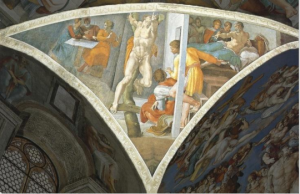 The Festival of Purim is the celebration of God’s intervention to save the Jews of Persia from the evil Haman in the 5th Century BCE.
The Festival of Purim is the celebration of God’s intervention to save the Jews of Persia from the evil Haman in the 5th Century BCE.
Based on a document in the Vatican Archives we learn that the festival of Purim was celebrated in Jerusalem in the year 78 BCE. Similarly, from the Theodosian Code dated 438 CE, we learn that as part of the celebration of Purim, Jews in the Roman Empire would burn an effigy of Haman on a cross. Notably, in the Sistine Chapel in 1511, Michelangelo depicted Haman on a cross.
In the Hebrew Bible, the Book of Esther consists of 10 chapters and attributes the exact time period of Queen Esther to the reign of Xerxes I (486-465 BCE). Ahasueras is Xerxes, the Persian king who fought the Spartans at Thermopylae in 480 BCE (The movie “300”). As stated in the Book of Esther, King Xerxes was approached by Haman, who said:
“If it pleases the king, let a decree be issued to destroy them (the Jews), and I will give ten thousand talents of silver to the king’s administrators for the royal treasury.” (Esther 3:9)
Some observe that Xerxes accepted Haman’s offer because the king’s treasury was depleted by the military misadventure against the Spartans.
However, the Catholic Bible follows the Codex Vaticanus written in Greek in 350 CE in Caesaria (Israel) and has an additional six chapters. The Codex Vaticanus was translated into Latin by St. Jerome in 382 CE.
Notably, the Vatican document from 78 BCE includes the 16-chapter narrative as well as a letter sent from Jerusalem to the Jews in Egypt. It states:
“In the fourth year of the reign of Ptolemy and Cleopatra [i.e., 78-77 B.C.], Dositheus, who said he was a priest and Levite, and his son Ptolemy brought the present Letter of Purim [to Egypt], saying that it was genuine and that Ptolemy’s son Lysimachus, of the community of Jerusalem, had translated it.”
Possible observations for the differences include:
- Jews in Judah found it unacceptable that “God” was not named in the original Esther text, whereas “God” is directly mentioned in all other Books of the Bible.
- By changing the time period, the return of the Jews led by Ezra in 458 BCE and Nehemiah in 445 BCE to Jerusalem is also a sign of God’s deliverance.
- 78 BCE is within the time period of the last Jewish Kingdom established by the Maccabees, and a sign of God’s deliverance from the Seleucid Greeks.